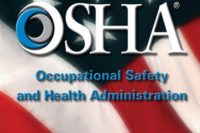 In a press tele-conference last week, OSHA chief Dr. David Michaels once again took the opportunity to promote the much-ballyhooed and controversial Injury and Illness Prevention Plan (I2P2).
In a press tele-conference last week, OSHA chief Dr. David Michaels once again took the opportunity to promote the much-ballyhooed and controversial Injury and Illness Prevention Plan (I2P2).
“Certainly, we encourage employers to adopt and embrace I2P2,” he said. “In the VPP (Voluntary Protection Program) thousand of companies have adopted the principles of I2P2. So we know it works.
It is a systematic way to address chemical exposures; it is certainly a way.”
Dr. Michaels shows no inclination to back off his cheerleading for I2P2. He’s doing all he can to make industry aware of I2P2 principles short of actually setting a regulation. That’s years away, a fight for another administration. To mix metaphors, Michaels is either tilting at windmills or simply trying to move the I2P2 “football” down the field. And it surely is a political football, with opponents groaning over its requirements and enforcement issues much more loudly than supporters have come out it favor of it.
Below is an excerpt from OSHA’s website touting the benefits of I2P2 and trying to create much greater employer awareness and acceptance of the program:
Injury and Illness Prevention Programs are universal interventions that can substantially reduce the number and severity of workplace injuries and alleviate the associated financial burdens on U.S. workplaces. Many states have requirements or voluntary guidelines for workplace injury and illness prevention programs. Also, numerous employers in the United States already manage safety using Injury and Illness Prevention Programs and we believe that all employers can and should do the same. Most successful injury and illness prevention programs are based on a common set of key elements. These include: management leadership, worker participation, hazard identification, hazard prevention and control, education and training, and program evaluation and improvement. This topics page provides information relevant to Injury and Illness Prevention Programs in the workplace.
Good for Workers.
Every day, 12 workers are killed on the job and more than 9,000 workers suffer a serious job-related injury. Injury and Illness prevention programs will save lives and prevent injuries daily.
Good for Businesses.
For every dollar spent on an Injury and Illness Prevention Program, an employer can expect up to six times a return on its investment.
Good for America.
Studies have shown that a direct correlation exists between a company’s performance in safety and its subsequent performance in productivity and financial results. Injury and Illness Prevention Programs will help American businesses remain competitive in a global market.
The major elements of an effective program include:
Management Leadership
• Establish clear safety and health goals for the program and define the actions needed to achieve those goals.
• Designate one or more individuals with overall responsibility for implementing and maintaining the program.
• Provide sufficient resources to ensure effective program implementation.
Worker Participation
• Consult with workers in developing and implementing the program and involve them in updating and evaluating the program.
• Include workers in workplace inspections and incident investigations.
• Encourage workers to report concerns, such as hazards, injuries, illnesses and near misses.
• Protect the rights of workers who participate in the program.
Hazard Identification and Assessment
• Identify, assess and document workplace hazards by soliciting input from workers, inspecting the workplace and reviewing available information on hazards.
• Investigate injuries and illnesses to identify hazards that may have caused them.
• Inform workers of the hazards in the workplace.
Hazard Prevention and Control
• Establish and implement a plan to prioritize and control hazards identified in the workplace.
• Provide interim controls to protect workers from any hazards that cannot be controlled immediately.
• Verify that all control measures are implemented and are effective.
• Discuss the hazard control plan with affected workers.
Education and Training
• Provide education and training to workers in a language and vocabulary they can understand to ensure that they know:
−−Procedures for reporting injuries, illnesses and safety and health concerns.
−−How to recognize hazards.
−−Ways to eliminate, control or reduce hazards.
−−Elements of the program.
−−How to participate in the program.
• Conduct refresher education and training programs periodically.
Program Evaluation and Improvement
• Conduct a periodic review of the program to determine if it has been implemented as designed and is making progress towards achieving its goals.
• Modify the program, as necessary, to correct deficiencies.
• Continuously look for ways to improve the program.
For more information, visit the Injury and Illness Prevention Program page on OSHA’s website at: www.osha.gov/dsg/topics/safetyhealth.
Twenty-seven states operate their own occupational safety and health programs approved by OSHA. States enforce similar standards that may have different or additional requirements. A list of state plans is available at www.osha.gov/dcsp/osp.




